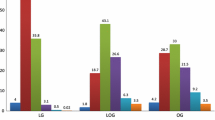Abstract
Fifty-eight pathological gamblers receiving treatment for addictive illness in two South Dakota hospitals were assessed for types of gambling and grouped into three categories; 15 “video lottery only” (VLO), 36 “video lottery mixed” (VLM), and 7 “not video lottery” (NVL). There were 51 male and 7 female respondents, with a mean age of 38.2. We hypothesized that video lottery would be the predominant type of gambling on several dimensions: level of recent activity, most money lost on one occasion, and number of DSM-IV criteria met. Of all gamblers, 87.9% had pathological involvement with video lottery. Video lottery gambling accounted for the highest level of recent activity. In the VLM group, video lottery gambling led to greater single-occasion monetary losses. In addition, significantly more DSM-IV criteria were met in the VLM group for video lottery gambling than for other forms of gambling these subjects had engaged in. Results indicate that video lottery gambling is the predominant type of gambling behavior engaged in by gamblers seeking treatment for addictive illness in South Dakota. We propose that these findings could be associated with the availability and stimulus differences between video lottery and other gambling types.
Similar content being viewed by others
References
American Psychiatric Association (1994).Diagnostic and statistical manual of mental disorders. (4th ed.) Washington, DC: American Psychiatric Association.
Bouts, P., & Van Avermaet, E. (1992). Drawing familiar or unfamiliar cards: Stimulus familiarity, chance orientation, and the illusion of control.Personality and Social Psychology Bulletin, 18, 331–335.
Carr, R., Buchkoski, J., Kofoed, L., & Morgan, T. (1996). “Video lottery” and treatment for pathological gambling: A natural experiment in South Dakota.South Dakota Journal of Medicine, 49, 30–32.
Dickerson, M., Hinchy, J., & England, S.L. (1992). On the determinants of persistent gambling behavior. I. High-frequency poker machine players.British Journal of Psychology, 83, 237–248.
Gfellner, B. (1994).A profile of VLT gamblers in Brandon, Manitoba (Report to the Brandon Crime Prevention Committee). Brandon, Manitoba: Brandon University, Department of Psychology.
Griffiths, M. (1991). Psychobiology of the near-miss in fruit machine gambling.Journal of Psychology, 125, 347–257.
Griffiths, M. (1994). An exploratory study of gambling cross addictions.Journal of Gambling Studies, 10, 371–384.
Jacobs, D.F. (1988). Behavioral aspects of gambling: Evidence for a common dissociative reaction among addicts.Journal of Gambling Behavior, 4, 27–37.
Kofoed, L., Buchkoski, J., Carr, R., & Morgan, T. (1993). MMPI-2 comparison of Veteran video lottery gamblers, other gamblers, and alcoholic controls. Unpublished manuscript, University of South Dakota, Sioux Falls.
Langer, E. (1975). The illusion of control.Journal of Personality and Social Psychology, 32, 311–328.
Lesieur, H.R., & Blume, S.B. (1987). The South Oaks Gambling Screen (SOGS): A new instrument for the identification of pathological gamblers.American Journal of Psychiatry, 144, 1184–1188.
Lesieur, H.R., & Blume, S.B. (1990). Characteristics of pathological gamblers identified among patients on a psychiatric admissions service.Hospital & Community Psychiatry, 41, 1009–1012.
Lesieur, H.R., & Blume, S.B. (1993). Revising the South Oaks Gambling Screen in different Settings.Journal of Gambling Studies, 9, 213–233.
Linden, R., Pope, H., & Jonas, J. (1986). Pathological gambling and major affective disorder: preliminary findings.Journal of Clinical Psychiatry, 47, 201–203.
McCormick, R., Russo, A., Ramirez, L., & Taber, J. (1984). Affective disorders among pathological gamblers seeking treatment.American Journal of Psychiatry, 141(2), 215–218.
Montana Department of Justice, Gambling Control Division (1990).Annual report: Fiscal Year 1990. Helena, Montana.
Reid, R. (1986). The psychology of the near miss.Journal of Gambling Behavior, 2, 32–39.
Rosenthal, R.J. (1992). Pathological Gambling.Psychiatric. Annals, 22, 72–78.
Volberg, R.A., & Steufen, R. (1991).Gaming in South Dakota. Business Research Bureau, University of South Dakota.
Woster, T. (1995, June 19). Video lottery a year after the shutdown.Sioux Falls Argus Leader, pp. A1, A7.
Author information
Authors and Affiliations
Additional information
The authors would like to thank Larry Atwood, Chemical Dependency Counselor at Keystone Treatment Center in Canton, S.D., for his assistance with data collection.
Rights and permissions
About this article
Cite this article
Morgan, T., Kofoed, L., Buchkoski, J. et al. Video lottery gambling: Effects on pathological gamblers seeking treatment in South Dakota. J Gambling Stud 12, 451–460 (1996). https://doi.org/10.1007/BF01539188
Issue Date:
DOI: https://doi.org/10.1007/BF01539188




